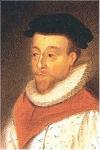Biography
One of the last great polyphonic english composers, Orlando Gibbons was the last of four sons of a family of musicians. Born in Oxford in 1583 to William Gibbons, who was appointed a wait at Cambridge in 1567, Orlando soon became heavily involved in church music. His eldest brother, Edward was a priest vicar at Exeter Cathedral where a few of his compositions still remain.
Ellis, another brother, managed to have two madrigals published in Thomas Morley's collectin o 1601, The Triumphs of Oriana.
Orlando surpassed them all.
In 1695 at the age of 12 he became a chorister at King's College Cambridge. At King's he was continuously envolved in the music of the royal College, and a few times he recieved money for compositions written for special occasions.
In 1606 he achieved his Bachelaureate in Music, after being appointed organist to the Chapel Royal at the age of 21; a position he retained for life.
By 1622 Gibbons star was on the rise, and he was awarded an honorary Doctorate of Music from Oxford. Later that same year he was appointed organist at Westminster Abbey. There he presided over the funeral of James I.
While returning to London with his Majesty, Charles I from Dover, Gibbons died in Canterbury on June 5, 1625. He is buried in Canterbury Cathedral.
Of Gibbons seven children, only one Christopher seemed to have inherited his fathers passions for music. Many of his key board compostions remain, and he is seen as a notable contributor to teh stage music of his era.
Surprisingly most of Gibbons music was never published in his lifetime. Most of his music was written for the Anglican rite, however there is a large amount of keyboard music written for secular occasions along with masterful madrigals, such as The Silver Swan. Gibbons did manage to publish a book of madrigals in 1612, a Viol book in 1610, and he remained the master of English organ music during his life.
Gibbons wrote over 40 anthems, yet only around 15 are polyphonic, the rest are what are called "verse anthems". Within these 15 anthems are such works as, 'O Claps Your Hands' and 'Hosanna to the Son of David'.
The most famous of all the madrigals Gibbons wrote is The Silver Swanne, included in the only collection published by the composer, The First Set of Madrigals and Mottets, apt for Viols and Voyces, which appeared, advertised as newly composed, in 1612. Some of these have more of the form of consort songs, for solo voice and instrumental accompaniment, and could be performed in this way, rather than with each part sung. Gibbons's consort songs include a remarkable concoction, The Cryes of London, for five voices and five viols, a composition that makes use of the street cries of hawkers and vendors in London in his time.
Most of Gibbons music was published after his death. First among these were the inclusion of Gibbon's services, preces, a few psalms, and five anthems in J. Bernard's First Bookf of Selected Church Musick in 1641. Three additional anthems were published along with the first service in W. Boyce's Cathedral Music in c.1766. Gibbons music is the transition between the period of William Byrd, and the early Baroque of Henry Purcell. ..






